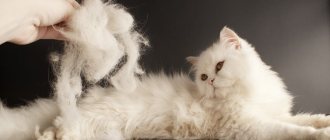10542Administration
1
Bald patches above the eyes in cats occur as a result of allergies, fleas or ticks, malnutrition, diabetes, thyroid pathologies, and dermatomycosis. Baldness in the eye area is a characteristic sign of subcutaneous demodex mites.
If you notice a receding hairline in the area of the eyes and ears in a cat, you must urgently contact a veterinarian for an examination, diagnosis and prescription of an effective therapeutic course.
© shutterstock
Why does baldness occur?
There are many factors that provoke the manifestation of alopecia. Most often, this phenomenon occurs in short-haired cats. Before moving directly to the treatment of pathology, it is necessary to understand what caused the disease. The most common cause of a receding hairline is food allergies. Most often, cats are allergic to foods such as lamb, cereals, and proteins of plant or food origin. By adjusting your pet's diet, you can improve its health.
Hormonal imbalance can also cause the formation of bald spots in a cat. In this case, hair falls out not only in the ears or around the eyes, but also in other areas. With hormonal imbalance, baldness occurs in the abdomen, chest, hind legs, armpits, and also in the area near the anus.
Stress can trigger baldness in cats. When the cause of a skin disease is a psychogenic factor, the cat may also begin to lose hair in the abdomen, thighs and inner surface of the paws. In this case, the owner needs to provide his pet with the most peaceful living environment possible. Calming medications intended for cats will also have a beneficial effect on the health of your four-legged friend.
Alopecia sometimes results from dermatomycosis. In this case, increased hair loss is noticed in the area of the eyes and ears. The shape of bald patches with dermatomycosis is ring-shaped or rounded. In problem areas, the skin is quite dry, however, the cat is not bothered by itching. The cause of the development of dermatomycosis is fungal diseases that negatively affect the epidermis and fur of the pet. Treatment of bald patches in cats is carried out using special antifungal agents.
Dermatomycosis
Animals of any age and breed can become infected with it after contact with infected cats. A tick can live in a pet’s body for a long time and not appear. To activate the disease, a provoking factor is needed, for example, a decrease in immunity.
As a result, the tick in the cat’s body begins to lead active life activities, having a negative impact on the overall health.
In addition to bald patches near the ears, there may be redness of the skin, peeling in the eye area, skin rashes that look like small pustules, as well as the formation of small ulcers and bleeding wounds on the skin.
Other causes of the disease
In rare cases, the factor that causes the appearance of bald patches is the following serious illnesses:
- Acromegaly;
- Problems with the thyroid gland (hypothyroidism);
- Diabetes;
- The period after castration;
- Hyperfunction of the adrenal cortex (Cushing's syndrome);
Other pathologies can also provoke the formation of bald spots. Some cats develop skin diseases due to allergies to medications. The presence of parasitic diseases also sometimes leads to alopecia.
In this case, it will be easy to notice the presence of parasites, since the influence of mites, lichen and cat scabies will immediately be reflected in the condition of the coat. In rare cases, bald patches appear in the presence of benign or malignant tumors. Hereditary factor is another reason for cat baldness.
The most common causes of alopecia
There are many different reasons why a cat can go bald, but the results often look the same. Therefore, it is important to be able to differentiate the sources of the disease, which will allow for effective treatment. Naturally, a specialist must make a diagnosis and prescribe treatment measures.
Veterinary dermatologists have listed the most common causes of alopecia in cats.
Dermatophytoses (lichen)
Ringworm is the most common cause of baldness. It is caused by the fungus microsporum canis. Bald spots are localized on the cat's head and face. In dermatophytosis, the hair follicles become infected and damaged, causing hair loss in the affected areas.
Depending on the location and intensity, lichen can be:
- local – isolated areas exposed to infection;
- focal – several foci;
- generalized – multiple lesions.
Important! Contrary to popular belief, lichen does not always cause itchy skin. Therefore, you should not reassure yourself that the cat does not itch.
Only a veterinarian can diagnose dermatophytosis, and he will prescribe the appropriate treatment. You should not treat your cat yourself - the disease can become chronic. With proper treatment, complete recovery is guaranteed.
Parasites (fleas, ticks)
When a cat's skin is infected with demodex - skin mites - patches of baldness can also form. Demodicosis is caused by 2 types of pathogens:
- Demodex gatoi. Contagious. A cat can become infected with it on the street or from a sick animal. The affected areas itch, the cat scratches them, and in the places where they scratch, the cat becomes bald. In this case, there is self-induced alopecia.
- Demodex cati. Not contagious. It is an opportunistic agent that lives on the skin of a healthy cat. When immunity decreases and serious diseases (for example, diabetes) occur, the tick becomes more active. On the affected areas of the skin, hair begins to fall out. The cat does not feel itching - this is typical for spontaneous alopecia.
Self-induced partial baldness is caused by fleas. Their bites are sensitive to cats. They scratch, lick, bite itchy places, and thereby damage the coat and skin. It is even possible that ulcers will appear.
Self-induced alopecia can be caused by the following parasitic infections:
- Notoedrosis - accompanied by severe itching, the cat scratches the skin until scabs form. The lesions are localized on the neck and head.
- Otodecosis is caused by ear mites. Scratching on the head, especially around the ears, can cause bald spots.
- Lice eaters - damage the coat. The infection causes the cat to itch and develop bald patches on the affected area.
- The scabies mite is a parasite that eats passages in the upper layers of the skin, causing unbearable itching. The cat scratches itself until it bleeds.
Allergies
Another reason that a cat goes bald is allergies. It can be food and atopic - caused by allergens contained in the air or in the environment.
In the food form, the allergen enters the cat’s body as a result of the owners’ careless attitude to the diet. Some cheap industrial food can cause an allergic reaction in a cat.
Bald patches on a cat photo
Features of treatment
You can eliminate bald patches in a cat above the eyes or in another problem area by addressing the root cause of the disease. If parasites are the cause of the skin disease, it is necessary to provide the pet with proper treatment. The use of special ointments, gels and sprays that effectively affect parasites will help improve the condition of your pet. The cat owner should give the animal vitamins that will increase its immunity.
If local baldness occurs as a result of allergies, then it is necessary to limit contact with allergens. A hypoallergenic diet will improve your cat's health. In this case, the veterinarian prescribes the animal to take antiallergic drugs and immunostimulants.
When an animal has problems with the endocrine system, then it is recommended to select special treatment. Taking hormones will improve the cat's health and return its coat to its previous appearance.
Why do my cat's ears go bald?
When owners notice that a cat’s ears are going bald, they should pay attention to the animal’s diet, since a similar problem is possible due to a lack of vitamins and microelements in the cat’s body. Baldness around the ears may also indicate endocrine and other serious diseases that require urgent medical treatment. As soon as a kitten has areas without hair near its ears, its legs become bald, and other symptoms of a sore appear, it is worth contacting a veterinary clinic for examinations and selection of therapy.
Preventive measures
Preventing skin disease such as alopecia is not difficult. To do this, you must adhere to the following measures:
- Observe hygiene rules. The owner must remember to inspect the cat’s fur (especially if he is often outdoors) for ticks and other parasites and deal with them in a timely manner;
- Provide the animal with a balanced diet. The cat's diet should contain vitamins and other useful microelements;
- Carry out routine vaccinations for your pet;
- Visit the veterinarian periodically. During the examination, a specialist can identify possible pathologies;
There is no need to “sound the alarm” if your beloved cat has bald patches on his skin. This phenomenon is not uncommon for most cats. If you find the cause of the pathology in a timely manner and carry out treatment, it is easy to return your pet to vigor and health.
I graduated from the National State Agricultural Academy and have been working as a veterinarian for 8 years.
In my free time, I write articles about the diagnosis and treatment of cats.
Feel free to ask questions in the comments, I will try to answer everything.
Quite often, baldness around the eyes of a cat can be associated with seasonal shedding, which lasts 1-2 weeks. If this process is prolonged or accompanying symptoms appear, then the option of molting disappears and you should think about possible problems with nutrition (incorrectly selected food often causes food allergies), parasites or bacterial infection.
What is alopecia
In cats that constantly live in an apartment and do not go outside, shedding occurs almost all year round with greater or less intensity. It is normal for pets to lose a lot of fur. During periods of heavy shedding, a cat's fur may fall out in clumps, and the coat will noticeably thin out. If the animal feels well, its nose is clean and moist, and its appetite is excellent, there is nothing to worry about.
But sometimes hair loss occurs according to the “wrong” scenario: the cat’s hair falls out and non-healing bald spots form. In this case, the owner should be concerned: perhaps these are alarming symptoms of alopecia. This term means “baldness”, “baldness”.
With pathological alopecia, bald spots form on the cat's body - areas devoid of fur. They can be located on the back, symmetrically on the animal’s hind legs and sides, and on the ears. Possible places for hair loss: muzzle, stomach, groin area.
Based on the causes of baldness, the disease is divided into:
- Symptomatic alopecia. It is associated with a specific disease, and baldness acts as a concomitant symptom.
- Idiopathic alopecia. Acts as an independent disease.
In most cases, baldness is accompanied by itching, redness and flaking of the skin. The condition is differentiated by location on the cat’s body into:
- diffuse alopecia – fur is lost abundantly throughout the body;
- localized alopecia - only one area is affected;
- partial alopecia - there may be several affected areas.
The appearance of receding hairline: reasons
The area of the skin where hair has fallen out is called a receding hairline; such a change is not normal and can appear for various reasons, including:
- Allergic reaction to food, medications.
Allergies to food (industrial feed, lamb, cereals), medications often develop in cats. Signs of the pathological condition: baldness of the skin near the ears and eyes, on the stomach, constant itching, redness of the bald areas.
Hair loss may indicate hormonal imbalances in the animal’s body, indicating the development of diseases such as: pathologies of the thyroid gland, diabetes mellitus, malfunction of the adrenal glands, malfunctions of the internal glands. Additional signs of hormonal imbalance are: excessive drinking of water, frequent urination, sudden weight loss.
Hair loss can occur if the cat is infected with ringworm. Infection occurs through contact with a carrier of parasites; the disease may not manifest itself for a long time. Subcutaneous mites begin to actively develop if the pet’s immunity is weakened.
Additional symptoms: flaky skin, the formation of bleeding wounds, ulcers above the eyes. Fleas can also cause baldness, biting parasites bother the animal, the cat begins to intensively scratch the skin, as a result of which the hair roots become weak and the hair falls out.
Signs of pathology
Alopecia is an anomaly that occurs due to a malfunction in the body and requires medical intervention. Large bald areas and bald spots on the pet's body should alert the owner.
Signs of pathology:
- severe hair loss during scratching and walking;
- the hair falls out in clumps, leaving bald areas in the area of the ears, back, tail and other parts of the body;
- the hair on one side is thicker than on the other;
- the skin on bald areas is not pinkish, as it should be normally, but red;
- peeling, ulcers, wounds and scabs are noticeable on the skin;
- the animal scratches the bald spot vigorously, possibly to the point of bleeding;
- touching the skin causes anxiety in the cat or, conversely, apathy.
If you notice one or more of the listed symptoms in your pet, take immediate action.
Remember that timely treatment is much more effective than therapy in severe stages of the disease.
How to distinguish normality from pathology?
Baldness of skin areas is not always caused by pathological reasons. In some cases, hair loss occurs in cats that have recently given birth to kittens. The problem arises due to an unbalanced diet. A nursing mother needs increased nutrition and vitamin intake.
In animals of smooth-haired breeds, bald spots can occur as a result of regular licking of the fur, due to genetic predisposition.
Hair loss may indicate nervous strain that has arisen in the cat as a result of moving or having a new pet. Such situations are stressful for the pet; treatment is by taking sedatives.
Vitamin deficiency can be another reason for hair loss.
Alopecias that are associated with breed
Genetic predisposition to baldness deserves special attention. As a result of targeted breeding work, felinologists have developed cat breeds whose genes contain this anomaly. Sphinx, Ukrainian Levkoy, bambino, cojona, elf - the fruits of the labors of breeders. So to speak, they have beneficial alopecia.
Persian cats are particularly prone to dermatophytosis. The reason for this is probably their weak immunity. They are also more susceptible to chronic lichen than others. The trouble with this disease is its frequent relapses.
The disease is severe and seriously undermines the Persian’s health. Considering that rich and fluffy hair is the main advantage of the breed, then the tendency to baldness is a serious problem for Persian cats.
Bald patches near the ears
The development of characteristic bald spots near the ears of an animal (periacular alopecia) occurs in a cat for the same reasons as hair loss above the eyes.
To make a diagnosis and prescribe treatment, your pet should be taken to a veterinary clinic, where the doctor:
- will conduct a visual inspection,
- will prescribe a series of tests,
- take scrapings from the skin,
- Based on the data obtained, he will prescribe treatment.
What to do if you find bald spots?
Immediately show the animal to a veterinarian. You should not engage in treatment and find out the causes on your own. It is best to entrust the health of your pet to a specialist. At the veterinary clinic, they will carefully question you about your pet, do a thorough examination, prescribe a specific and general blood test, take a scraping of the epidermis, microbiological examination of the roots of the animal’s fur, and if there is a suspicion of a neoplasm, they will do an ultrasound or x-ray. Depending on the results of the examination, appropriate treatment will be prescribed.
At the veterinarian's appointment.
If the reason is in the diet, then they will definitely prescribe a change in food, it will be necessary to remove lamb, cereals, cereals, proteins of plant and animal origin from the diet, and prescribe vitamins.
no, no, no, darling!
We remove lamb and animal proteins from the diet.
If you have an allergy, you need to exclude the allergen and prescribe antihistamines.
If the cause of baldness is stress, then sedatives are prescribed.
Inflammatory formations are treated by treating the skin with antiseptics and antibiotics.
In case of scabies, fleas, lichen or fungus, the doctor prescribes specific treatment.
For neoplasms, the tactics are decided by the doctor individually, depending on the stage of the disease.
The appearance of bald patches: what to do
A cat owner who notices the appearance of bald spots should not self-medicate. The pet should be taken to a veterinarian to determine the cause of the illness. The doctor will conduct an examination and prescribe adequate treatment.
Prevention measures:
- feeding with quality feed,
- regular hygiene procedures,
- timely vaccination of the animal,
- taking vitamin complexes,
- regular checkups with a veterinarian.
Review of possible pathologies
If a cat develops bald patches above the eyes due to scratching, then the cause must be sought in pathology, which can cause severe itching in the area of the nose, forehead, temples and organs of vision. First of all, exclude the option of parasites, whose bites can cause severe irritation, especially in allergic breeds. And then, based on the existing symptoms and diagnostic measures carried out, they sort out the possible causes:
- Fungus. Due to ringworm, a cat may develop bald patches above the eyes, ears, near the tail and limbs. The lesions look like bald spots, inside of which there are wet areas of skin that are predominantly red. Itching is present in almost all cases; because of it, the animal may develop large scratches, often complicated by secondary infection. Most cases of fungal infection occur in dermatophytosis (namely Microsporum Canis). The diagnosis can only be confirmed in laboratory conditions using a microscope and a Wood's lamp. In controversial or severe cases, culture may be required, which is considered the most informative in determining the pathogen. Based on the results of the analysis, drugs are selected that will have a detrimental effect on fungal spores. Most often the choice falls on Itraconazole, Terbinafine, Nizoral. At the same time, the room where the pet lives is disinfected. To do this, you can use special chlorine-containing substances that are added to water for washing floors and other surfaces. It should be noted that dermatophytes die at temperatures above 50 degrees, so the animal’s sleeping place can be boiled (sheet or bedding). Much attention is paid to the disinfection of carpets and rugs, since a large number of fungal spores always remain on their surface. And finally, I would like to share the opinion of foreign experts who have proven that vaccination is not effective either in the treatment of lichen or in prevention. So don’t be fooled by illiterate veterinarians.
- Injury. In the form of deep scratches from claws or bites from the teeth of other animals. It may be very itchy as it heals. This will cause your pet to scratch the affected areas with its paws. This may explain the appearance of bald patches above the eyes of a cat. Therefore, if there is any damage to the visual organs that may itch during the healing process, it is best to use a special medical cap that limits the animal’s access to the wound.
- Fleas. Because of them, bald spots on cats above the eyes do not appear so often, but this option should not be ruled out. Especially if the pet, for no apparent reason, began to itch a lot. Unscheduled treatment of the animal with one of the parasitic drugs (Stronghold, Advocate, Frontline or Advantage) 2 times every 3 weeks will help eliminate this option.
- Conjunctivitis. Inflammatory process of the mucous membranes of the eyes. It is almost always a consequence of the animal having a disease associated with the organs of vision, allergies or an infectious process. With all types of conjunctivitis, profuse lacrimation is present. Dry crusts form around the eyelids. In every second case, severe itching is noted. Therefore, if a cat has developed bald patches above the eyes after a recent injury to the cornea, the possibility of developing conjunctivitis or keratitis should be ruled out.
- Allergy. A real problem for ornamental breeds, which often suffer from improperly selected food, reactions to flea saliva, plant pollen, house dust or mold. Therefore, when bald patches appear above the eyes in British cats and Maine Coons, they consider the option of food allergies. Often changing the brand of the manufacturer or switching to hypoallergenic food brings positive results. If there is redness, peeling of the skin and severe itching, antihistamines are prescribed.
The cat has a receding hairline above the eyes photo
Also, bald patches above the eyes can be caused by demodicosis, which is much less common in cats than in dogs. Distinctive features are black specks on the skin inside the bald area and the absence of itching. In many cases, it goes away on its own without any therapeutic measures.
If your cat begins to develop bald patches in the area of the ears or around the eyes, then this is not a reason to worry. A similar phenomenon is called periacular alopecia and occurs quite often in quadrupeds.
This disease is not accompanied by itching or burning. In each case, the cause of the disease is different. Having determined why cats have bald patches near the ears, it will be much easier to overcome the skin disease and return your pet’s coat to an attractive appearance.
Alopecia symptoms
You can recognize alopecia in a pet by the following signs:
- The fur falls out excessively, in clumps. Bald spots in cats appear mainly behind the ear, in the neck, back, and on the tail.
- The skin in these places may have its usual pink color or turn red, sores or scabs may appear there.
- Check your pet's reaction to touching the bald spot: perhaps the spot hurts or itches.
- Check if the animal has symmetrical bald spots.
If you notice these symptoms, you should urgently seek professional help from a veterinarian. Otherwise the disease will progress.
Why does baldness occur?
There are many factors that provoke the manifestation of alopecia. Most often, this phenomenon occurs in short-haired cats. Before moving directly to the treatment of pathology, it is necessary to understand what caused the disease. The most common cause of a receding hairline is food allergies. Most often, cats are allergic to foods such as lamb, cereals, and proteins of plant or food origin. By adjusting your pet's diet, you can improve its health.
Hormonal imbalance can also cause the formation of bald spots in a cat. In this case, hair falls out not only in the ears or around the eyes, but also in other areas. With hormonal imbalance, baldness occurs in the abdomen, chest, hind legs, armpits, and also in the area near the anus.
Stress can trigger baldness in cats. When the cause of a skin disease is a psychogenic factor, the cat may also begin to lose hair in the abdomen, thighs and inner surface of the paws. In this case, the owner needs to provide his pet with the most peaceful living environment possible. Calming medications intended for cats will also have a beneficial effect on the health of your four-legged friend.
Alopecia sometimes results from dermatomycosis. In this case, increased hair loss is noticed in the area of the eyes and ears. The shape of bald patches with dermatomycosis has a ring-shaped or rounded shape. In problem areas, the skin is quite dry, however, the cat is not bothered by itching. The cause of the development of dermatomycosis is fungal diseases that negatively affect the epidermis and fur of the pet. Treatment of bald patches in cats is carried out using special antifungal agents.
Hair loss in a cat due to physiological reasons
0 Source:
There are several types of reasons that affect the baldness of an animal. The first group includes physiological ones. For example, this is molting: the seasonal change of fur in domestic cats can sometimes drag on for 2-3 months. This is due to room temperature and jet lag. At the same time, a pet that loses hair profusely looks healthy. Another reason for this group is stress. It is a mistake to think that cats adapt to any situation. These animals have a subtle mental organization. Any stressful situation for them can trigger hair loss. Some breeds become completely hairless. Against the backdrop of hassle, the pet may lose appetite, become sad, and even get sick. Poor nutrition has a negative impact on the animal's appearance. Cats can go bald if they lack B vitamins. If the owner feeds his pet fried fish, sausage and other “delicacies” seasoned with salt and spices, then don’t be surprised by the clumps of fur on the floor. From such a diet, the cat will not only go bald, but will also develop gastrointestinal diseases. Physiological causes of baldness include pregnancy. During this period, cats undergo hormonal changes, and they also lack vitamins. In lactating animals, hair loss around the nipples is observed. Finally, old age is a natural cause of baldness. Older cats rarely have thick hair, but they are full of bald spots.
Other causes of the disease
In rare cases, the factor that causes the appearance of bald patches is the following serious illnesses:
- Acromegaly;
- Problems with the thyroid gland (hypothyroidism);
- Diabetes;
- The period after castration;
- Hyperfunction of the adrenal cortex (Cushing's syndrome);
Other pathologies can also provoke the formation of bald spots. Some cats develop skin diseases due to allergies to medications. The presence of parasitic diseases also sometimes leads to alopecia.
In this case, it will be easy to notice the presence of parasites, since the influence of mites, lichen and cat scabies will immediately be reflected in the condition of the coat. In rare cases, bald patches appear in the presence of benign or malignant tumors. Hereditary factor is another reason for cat baldness.
Principles of treatment
When starting to treat allergies, it is necessary to identify the allergen.
Reactions to flea and other insect bites can be eliminated by local treatment of the skin and hair with insecticidal agents. Particularly popular are drops on the withers - Bars, Barrier-super, Frontline.
Food allergies are eliminated by eliminating hazardous foods from the diet and prescribing antihistamines. Dust – creating conditions for a comfortable living of the animal: regular wet cleaning of the premises, cleanliness of the habitat.
Atopic dermatitis , due to the genetic nature of the disease and its chronic long-term course, is treated throughout life using maintenance therapy and the prevention of secondary pathologies.
The most common disease of the pancreas is pancreatitis . Since baldness can occur only with severe pancreatitis, treatment consists of intensive care, namely:
- elimination of pain – antispasmodics, painkillers, anesthetics, analgesics;
- combating dehydration - saline, colloidal solutions, droppers, injections;
- reduction in the production of destructive secretions - atropine and analogues;
- relieving edema and slowing down pancreatic functions - hormones, ribonuclease;
- removal of intoxication;
- severe case - surgical intervention.
Following a diet containing foods that have enveloping properties is mandatory.
Pyoderma
Pyoderma and bald spots.
Help for pyoderma consists of a complex of therapeutic measures: local treatment, oral medication, injections, herbal medicine. For local treatment, anti-inflammatory gels, tinctures, streptocidal ointment, Cefakure, Maxidin are prescribed.
Antibiotics – Tylozolin, Lincomycin hydrochloride, Clindomycin, Cephalexin, Erythromycin. Gamma globulins, Staphylococcal anatoxin, Evinton, Neoferon, Bactoneotim. Healing drugs – Gamavit, Katazol.
Herbal medicine – chamomile, celandine, calendula, sage, eucalyptus.
Hyperthyroidism
The goal of treatment for hyperthyroidism is to reduce the level of thyroid hormones in the blood.
There are two main treatment methods available: drug support throughout the entire life cycle and surgical removal of the gland. Long-term use of medications that inhibit the production of thyroid hormones containing thiourea is indicated. Medicines that support the functioning of the heart and the entire vascular system. Medicines that support kidney function.
Treatment of hypothyroidism comes down, first of all, to replenishing the deficiency of the hormone that led to the disease . The main drug prescribed for pathology is Levothyroxine sodium . The dose is selected individually for each animal, depending on the existing deficiency and body weight. The course for complete recovery is designed for four weeks of use. At the same time, we can take drugs that slow down the binding of serum proteins - glucocorticoids, salicylates.
Cushing's syndrome
Hair loss in clumps due to Cushing's syndrome.
The primary cause of Cushing's syndrome is hyperfunction of the adrenal cortex - the presence of adenoma, oncological diseases (tumors). Eliminated by surgical removal of tumors. Drugs used in the postoperative period: Chloditan, Cyproheptadine, Ketocanazole.
Bald patches on a cat photo
Features of treatment
You can eliminate bald patches in a cat above the eyes or in another problem area by addressing the root cause of the disease. If parasites are the cause of the skin disease, it is necessary to provide the pet with proper treatment. The use of special ointments, gels and sprays that effectively affect parasites will help improve the condition of your pet. The cat owner should give the animal vitamins that will increase its immunity.
If local baldness occurs as a result of allergies, then it is necessary to limit contact with allergens. A hypoallergenic diet will improve your cat's health. In this case, the veterinarian prescribes the animal to take antiallergic drugs and immunostimulants.
When an animal has problems with the endocrine system, then it is recommended to select special treatment. Taking hormones will improve the cat's health and return its coat to its previous appearance.
How to help a cat whose ears are going bald
After determining the cause, the cat owner will have to strictly follow the veterinarian's recommendations . Any deviation from the planned treatment plan is fraught with complications.
If baldness is caused by dermatitis caused by allergies, then you will have to part with even your favorite hyacinths, lilies and other potentially dangerous plants. Their list is not that long. This includes all types of euphorbia, indoor chrysanthemum, hippeastrum, sansevieria, clivia, primrose, poinsettia.
The medicine that caused baldness should be stopped immediately and special attention should be paid to its composition. It is likely that the irritation was caused by one component, and not their complex. Therefore, be careful when giving your pet all other medications with a similar composition, and ideally, their use should be supervised by a veterinarian. It is possible that the baldness was caused by food, in which case the veterinarian will prescribe a diet consisting of specialized foods. Many cat owners neglect it, and after a while a relapse occurs, i.e. after a short-term improvement, the cat begins to go bald again. To exclude this possibility, you need to give your pet only hypoallergenic food recommended by a veterinarian.
Bacterial infections can only be treated with antibiotics, and to get rid of the virus you will have to follow a whole set of rules. It includes diet, filling the animal’s diet with certain groups of vitamins, and the use of medications.
To eradicate the cause of the disturbance in the animal’s mental balance, you will also have to resort to the help of tablets , although in this case these will be mood modifiers and tranquilizers.
Preventive measures
Preventing skin disease such as alopecia is not difficult. To do this, you must adhere to the following measures:
- Observe hygiene rules. The owner must remember to inspect the cat’s fur (especially if he is often outdoors) for ticks and other parasites and deal with them in a timely manner;
- Provide the animal with a balanced diet. The cat's diet should contain vitamins and other useful microelements;
- Carry out routine vaccinations for your pet;
- Visit the veterinarian periodically. During the examination, a specialist can identify possible pathologies;
There is no need to “sound the alarm” if your beloved cat has bald patches on his skin. This phenomenon is not uncommon for most cats. If you find the cause of the pathology in a timely manner and carry out treatment, it is easy to return your pet to vigor and health.
Prevention measures
To protect your family pet from skin diseases that are accompanied by baldness, it is necessary to provide proper care for the cat:
- The first and most important thing is preventive examinations. You can do them yourself. While bathing, brushing, and playing with your cat, it is very convenient to check the condition of its coat. Regular monitoring will ensure that you do not miss the appearance of alarming symptoms.
- Timely vaccinations against infectious diseases will improve your pet's health.
- Regular (once every 4-5 months) antiparasitic treatment is a shield against skin diseases.
- Deworming medications are required for all cats.
- A calm and friendly atmosphere in the family without stress and scandals is useful not only for people, but also for cats.
- If the cat is about to move, change owners, or the house is about to be renovated, a good solution would be to use sedatives.
- You should not allow contact with unfamiliar animals - they can be carriers of the causative agent of alopecia.
- A balanced diet and proper nutrition are the key to a healthy cat.
To preserve not only the health, but also the beauty of your pet, it is important to be an attentive and sensitive owner. Taking timely measures will eliminate the disease at the very beginning - and this will relieve stress for both the cat and the owner. And it is important to always remember that self-medication can seriously aggravate the course of the disease.










